Answers to
How Good a
Corsetiere are You?
It is the 1960s, that decade of social upheaval and turbulence,
the ramifications of which are still being felt today.
In the 1950s, so many girls were carbon copies of their mothers
who tried to protect their offspring from the 'evils' of rock and roll. They
failed and with the advent of the Beatles, the social revolution began which, to
the horror of Spirella, ended with the demise of lower foundation garments in
general.
There are eighteen ladies present here, whose ages
range from 24 to about 70. This means that some of the older ladies were born around
the turn of the century, whilst the brides and bridesmaids would have been born
at the end of the Second World War. Ten are wearing corsets, seven are
wearing open-bottom girdles and one daring young thing is wearing the
new-fangled (in Britain anyway) long-leg, pantie-girdle.
The preponderance of corsets, indeed, the foundation garments being worn is not
necessarily typical of the era but might have been typical for a wedding party.
However, bear in mind that Spirella had a vested interest in promoting
structured underwear and these articles all come from the Spirella in-house
magazine. I remember being present as a bridesmaid at a wedding in 1967 and I
knew that my aunt wore a corset, my mother and myself wore girdles, although
mine was an un-boned roll-on, I mean how else would you keep up your stockings?
|
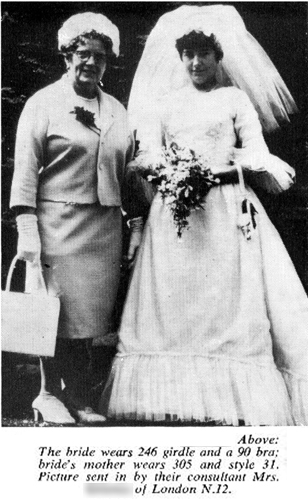
(1967) Mother
wears a corset and the daughter wears a conventional
girdle.
This is quite
old-fashioned for 1967 but not untypical for a wedding. |
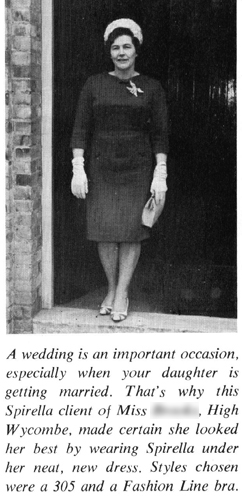
(1967) This
middle-aged lady is wearing a corset that, the article suggests, just might
have been specially bought for the wedding. |
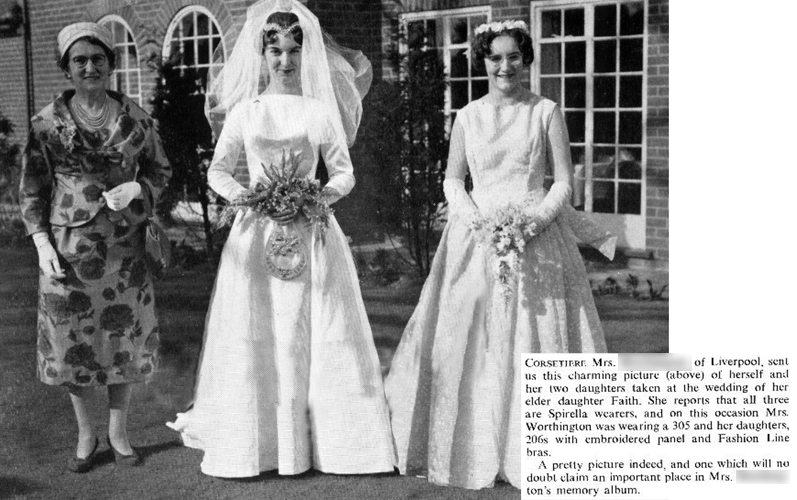
(1960) Once again,
the mother is in a corset and the girls in conventional
girdles but what else would you expect;
the mother is a corsetiere.
One assumes that
the fashion line bras were short-line (as opposed to long-line). Certainly
the girls do not need that much support. |
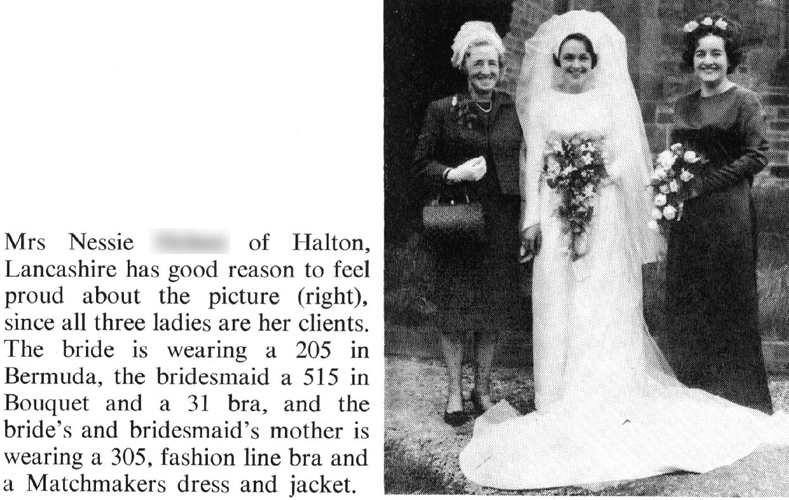
(1967) It looks like
all Spirella mothers wears corsets to weddings and why not, it certainly holds
in that tummy and holds up those support stockings that are clearly visible on
the two elderly women in the top row of pictures. The bride wearing a
conventional girdle is no surprise, but the bridesmaid, who looks to be similar
in size and shape to the bride, is wearing a 515, a front-laced laced corset.
This is definitely unusual although I know of a Scottish lady who wore a corset
in 1965 at the age of 15. She admits to being rather 'chunky' in those days and
her mother insisted that she wear a corset on a regular basis. She recounted how
mortified she was when a young male house guest saw her corsets lying across the
chair in her bedroom. Perhaps the bridesmaid's mother was firmer with her
daughter than the bride's mother.
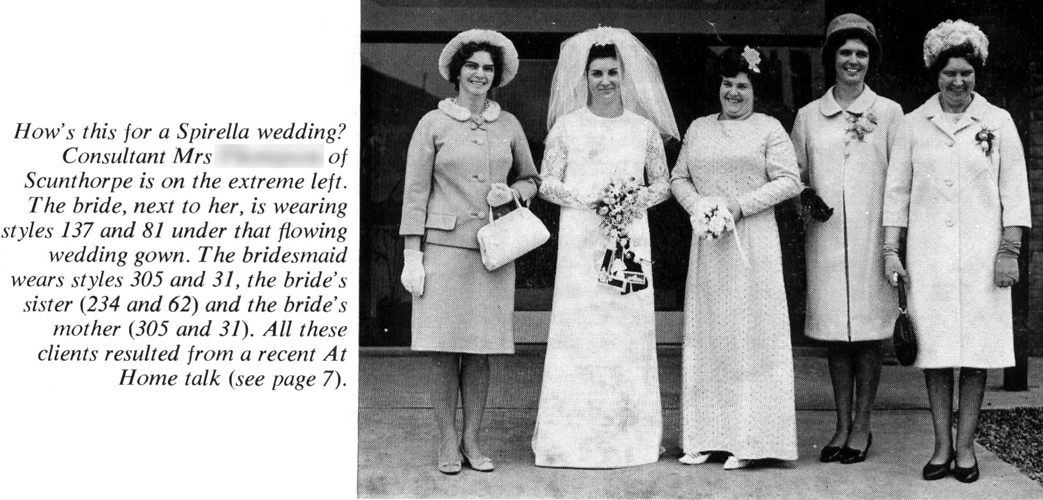
(1968) The Corsetiere
has not divulged her choice of foundation garment, however, if it was anything
less than a 305 corset, I would be most surprised. Moving left to right, here
comes the bride wearing a 137 girdle that really is the flimsiest of girdles
(see below). In contrast, to her left is indeed, a 'chunky' bridesmaid whose
burgeoning hips have effectively been squashed into tube-like narrowness by the
confines of a 305 corset. Definitely not standard wear for a late 20-year-old
but effective none the less. The older sister wears a more substantial girdle
and the mother, once again, a 305 corset. It is easy to imagine that both the
corsetiere and the mother might have wished for the bride to wear something a
little more substantial, not to mention profitable.
|
 |
(1969) The decade is nearly over
and something a bit different is going on here. The
wedding description below comes from November 1969 and refers to the picture on
the left. Note that even at the end
of the swinging 60's, two middle-aged women are wearing corsets and amazingly,
so is one woman barely into her 30's although she does look rather
stunning! From left to right, the corsetiere wears a 305 corset, what else.
The bride's mother wears
the complex (and
expensive)
325 corset, but she looks like the type that might. The bride, by way of a
contrast
wears a Spirelette 132 pantie-girdle (By 1969, the
panty-girdle had
definitely crossed the Atlantic and had taken a tenuous hold in Britain
- Ivy). The bridegroom's mother wears a Coppelia 44 girdle. These
were Spirella's off-the-shelf girdles. Would the bride's traditional mother
have approved? Certainly the bride's elder sister, who must be in her 30s is
wearing a corset but this is very old-fashioned for 1969. Perhaps the
younger bride has fallen for the social revolution that has left her older
sister unchanged. I suspect the corset might just be for 'special occasions'
only, such as this wedding.
An
exciting day for the bride and a proud moment for our consultant Mrs. H. of
Peterborough. The bride wore Spirelettes 83 and 132 , the bridegroom's mother
(on her left), a Coppelia 44 and Modern Line bra; sister of the bride (extreme
right of picture) wore a
305 and Fashion Line bra, and (on the bride's right)
her mother in a
325
corset and style 72 bra, and Mrs. H. in Spirella
foundations 305 and 30.
Reports Mrs. H.: "A guest at the wedding became
interested in Spirella and ordered a Coppelia girdle and bra. Another guest had
a Coppelia girdle and asked me to get her some
support
stockings." It was
Mrs. H. who, in the August issue, explained how she had secured orders while
helping out at a funeral. Is nowhere safe??
|
|
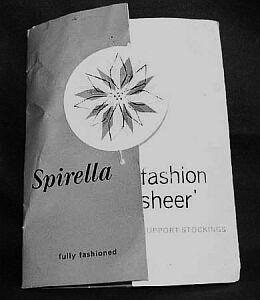 |
The reference
above to stockings is repeated several times in correspondence from
Spirella corsetieres. It was a clever ploy by the corsetiere to gain just a
little more commission. What could be easier, having fitted the wedding guest
with new brassiere and girdle for the occasion, to persuade her that some
support for her legs was required. "There will be so much standing around.
You really have to consider your poor legs". This ploy was so successful
that Spirella branded their own support stockings (left).
Spirella provided everything, even rayon
directoire knickers for the mother-in-law!
In the 1970's Spirella experimented with Matchmakers, a foray in the
world of the twin set, however, there were far more experienced fashion
retailers out there, and Spirella, ignoring it's core strength of
corsetry, paid a price later.
Spirella's experience with parachute nylon during the war
was used to good effect in knicker construction! |
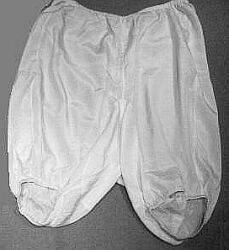 |
|
What lies beneath
From the Spirella catalogues of 1967 and 1968, we see the
choice of foundation garments available to the women above. The 137 and 135
girdles below show how desperate Spirella was at the end of the 1960s to get
the younger women interested in 'proper' foundation garments.
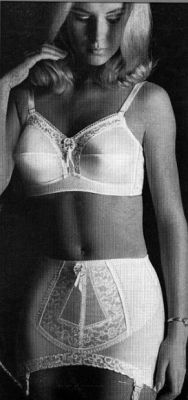
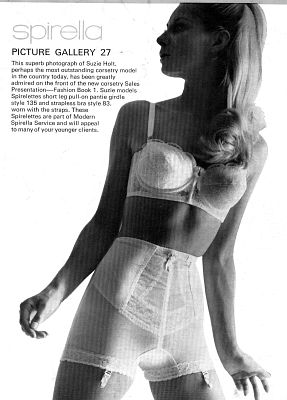
Of the more traditional 200-series girdles, the 234 and
246 were 1960s new developments of the 1950s 205, 206 and 207 to accommodate
the larger women expanding out of post-war austerity. |
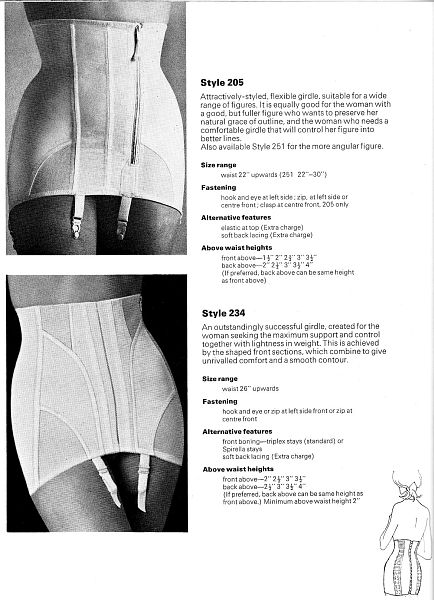
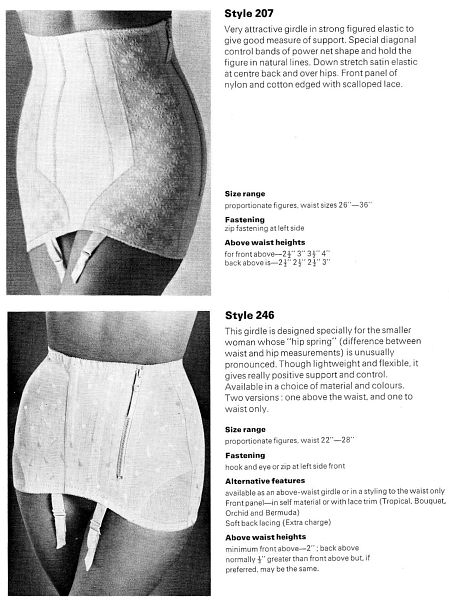
|
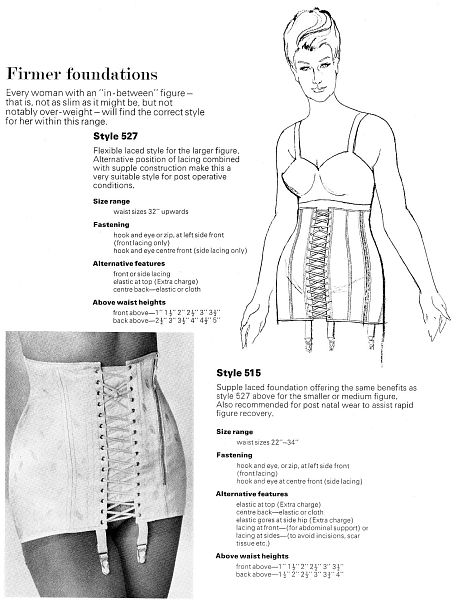
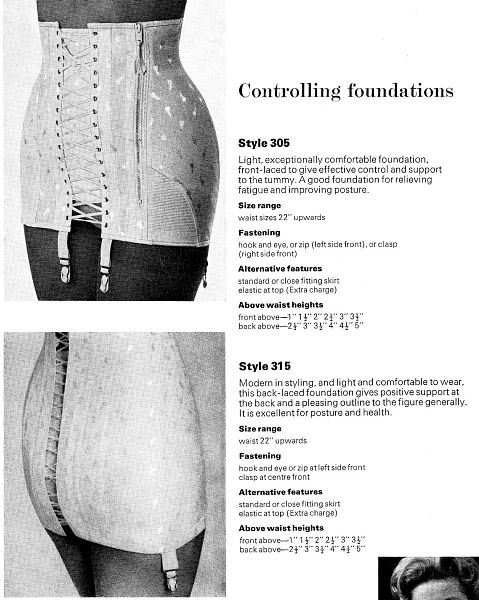
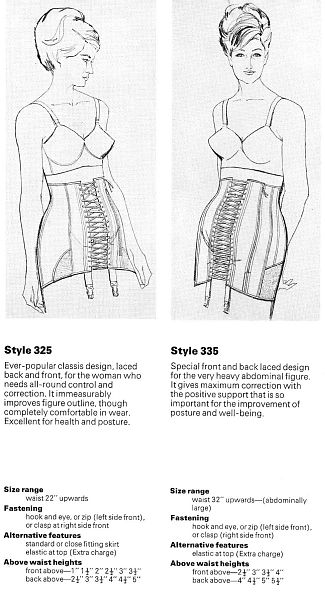
Of course, the
mainstay of Spirella's corsetry, the 300-series, had been available since the
1930s and outlast the girdles right until Spirella closed down at the end of the
1980s. More details about these corsets can be found on the
305 page.
















